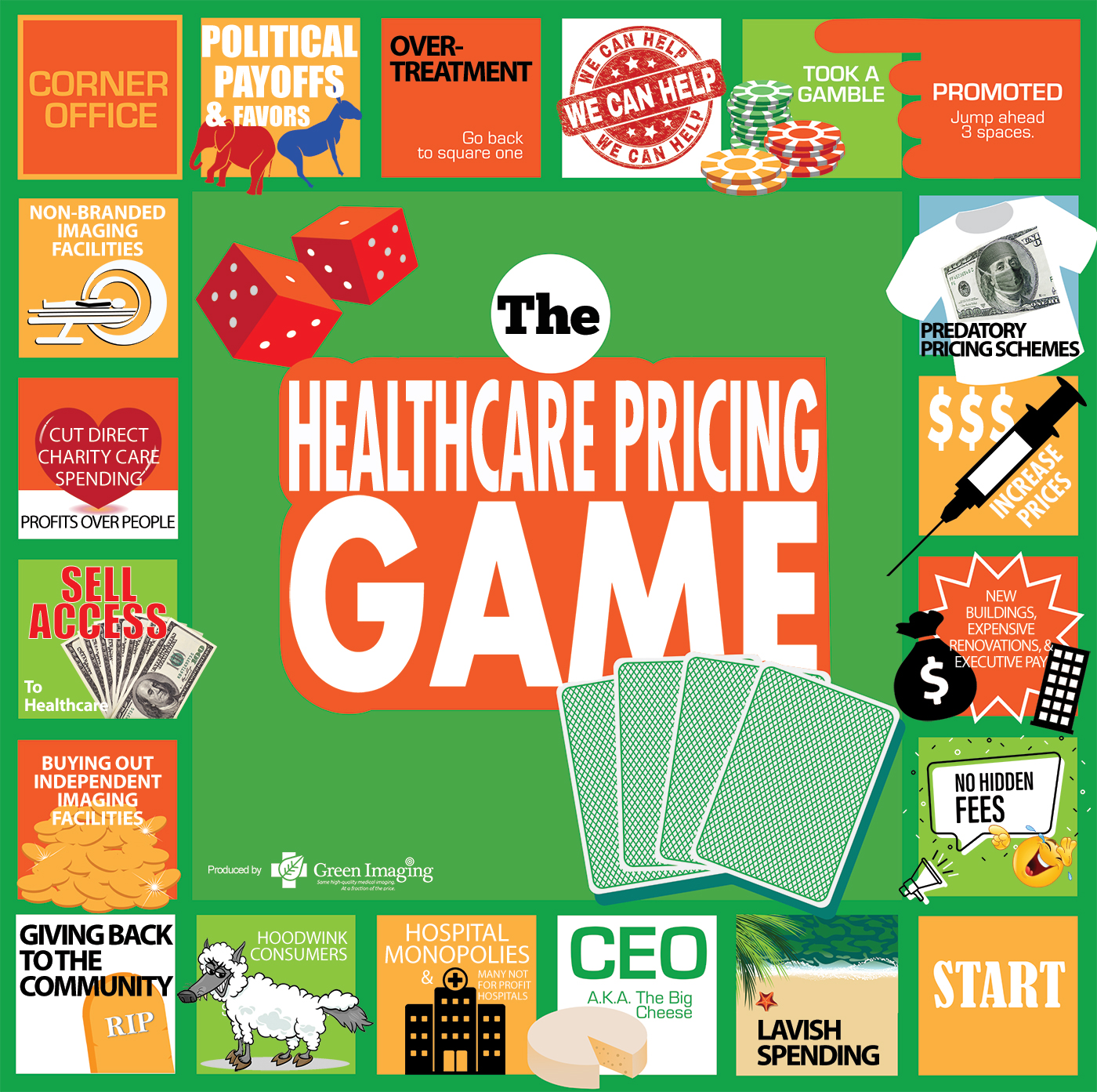
Deceit in Healthcare Pricing

Is This Just Sophisticated White Collar Robbery?
Just this year the healthcare industry quietly reached a momentous new milestone. No, it’s not Medicare-for-all or other politically explosive topics about the healthcare industry. Instead, it’s something far more sinister - the continuation of a broken status quo.
Healthcare prices keep rising year after year.
Employer premiums keep rising year over year.
Employee benefits keep shrinking year over year.
According to several news outlets, including the New York Times, Wall Street Journal, and Market Watch, the cost of employer-provided healthcare just broke $20,000 per employee. For employers and employees, that is not great news.
Imagine paying for a brand new car for every one of your employees every single year. If you are wondering why it doesn’t feel like you have received $20,000 worth of medical care - that's because you haven’t.
So where does all the money go?

Follow The Money
The case of the missing $20,000 always starts with what $20,000 even means in the healthcare industry.
While we can look at such a large amount and easily understand the potentially life-changing impacts a payday of $20,000 could look like to us, it is important to remember that numbers mean absolutely nothing in the medical world.
To the average individual, $20,000 looks like a new car. It could be college tuition for your kids. It could be the downpayment on your first house. When it comes to tangible goods and services, $20,000 is easy to comprehend for most. $20,000 is no small sum of money. For many, it is a new lease on life. It could mean no more credit card or college debt. It could mean they can finally join the housing market and carve out a little piece of the American Dream.
For businesses, $20,000 could mean an extra employee on the team, more attractive compensation for top talent, or sorely needed investments in equipment, maintenance, or infrastructure. $20,000 could be the competitive edge a business needs to survive and thrive in a competitive marketplace. Multiply that dollar amount by the number of workers a business employs, and one can truly see why unchecked healthcare prices are suffocating many businesses.
But in the healthcare industry, $20,000 is meaningless.
It is just a made-up amount on any number of secret medical pricing lists or negotiated insurance rates with hospitals. If you don't believe that, consider this. The same life-saving treatment could cost one patient $20,000, while another patient will never see a bill.
A hospital might bill a patient’s insurer $20,000 for a simple, everyday treatment with the expectation of getting reimbursed only a tenth of that number. $20,000 could really mean a $2,000 payout. Or, it could mean nothing at all. An MRI could cost $300, or it could cost $3,000. These absurd and seemingly random pricing practices abound in every sector of the healthcare industry, from hospital-owned outpatient diagnostic imaging facilities to the ER room.
According to many healthcare experts and advocates, that is precisely the problem. We spend twice as much on healthcare per person as a person in Canada does.
This year, 500,000 people will go bankrupt as a result of their healthcare debt. "Not for profit" hospitals are going to court and garnishing wages of patients they are supposed to be serving. Prescription drug prices have no rhyme or reason. The whole system is broken, and some contend that it is because healthcare has become a sophisticated form of white-collar robbery that is diverting the nation’s wealth from everyone, rich, poor, and middle-class, into the pockets of healthcare executives.
These made-up and inflated medical bills have severe real-world financial implications for both employers and employees alike. For some, misconduct in healthcare pricing and coverage can be a life and death matter. Eighty-seven million people put off or avoided seeing their doctors due to fear of unexpected and undesirable medical costs. As a result, many die from preventable diseases that could have been avoided.
"Practices such as hiding the true cost of procedures from consumers, or forcing consumers to only go to preferred in-network facilities, not only make the market less free, it makes it much easier to extract money from consumers."
--- DR. CRISTIN DICKERSON, MD
How to Get Away With The White-Collar Robbery Scam
Everyone knows that healthcare prices have skyrocketed, with no transparency, and no rhyme or reason. There is only the cold calculus of hospital price lists and financial algorithms designed to maximize value extraction and profits, not patient outcomes. And indeed, one must wonder where all the money we as Americans collectively spend on healthcare goes.
According to the Centers for Medicare & Medicaid Services and CIA World FactBook, Americans spent $3.65 trillion on healthcare in 2018. To put that number in perspective, we spent two times more money on healthcare than the entire economic output (GDP) of Canada.
$3.65 trillion translates to about $11,121 per person.
Canada, which has a socialized healthcare system, spent a little over half that amount.
Yet, we are certainly not consuming twice the amount of healthcare as our neighbors to the north. Nor is the quality of our healthcare twice as good. By many metrics, the United States lags behind when it comes to health outcomes compared to other developed countries around the world.
Naturally, this begs the following questions:
Are we getting a fair return on our collective healthcare investments?
Or, are we just being robbed blind by an indifferent and broken healthcare system?
Unfortunately, the evidence seems to point to the former. The $20,000 employers spend per employee on healthcare isn’t providing any functional health benefits. It’s just padding hospital and insurance company executives’ pockets.
Here’s how they get away with it:
- Opaque pricing practices
- Negotiated rates protected as trade secrets
- Monopolistic practices & price gouging
- Immense lobbying power
- Gaming Medicare & Medicaid
These are the tools that hospital conglomerates and insurance companies use to ensure that consumers remain in the dark about the real costs of healthcare goods and services.
So Who is to Blame?

The high cost of healthcare is an incredibly complicated problem. The healthcare industry itself employs one in ten Americans. It is undeniable that healthcare workers, whether they be frontline healthcare providers or support staff, have significantly benefited from the status quo. However, the real beneficiaries of the current system and the ones who reap the lion share of the financial rewards are hospital and health insurance executives.
Both hospitals and health insurance companies have reported record profits in recent years. Shiny new hospital buildings and office towers are just some of the visible signs of the obvious opulent wealth being extracted from everyday Americans.
What’s driving healthcare prices is a combination of hospital greed and insurer indifference. Hospital conglomerates, many of which hold de facto monopoly power in their local jurisdictions, dictate terms to insurers, employers, employees, and almost everyone else (with the notable exception of Medicare).
Health insurance companies are just as complicit. While in theory, it is the insurer's job to negotiate rates with hospitals and other healthcare providers, in practice, insurers often pass on the costs dictated by hospitals to their customers, both employers and employees alike, in the form of ever-higher premiums and ever-shrinking coverage.
The rise of bare-bones high-deductible health insurance plans in recent years is an excellent example of insurers providing essentially worthless health coverage. Many high deductible plans require patients to pay thousands of dollars out of pocket before they kick in, which only discourages patients from seeking the healthcare they need. It also encourages hospitals to charge outrageous prices with the expectation that the insurance company will pick up the tab once stated costs exceed an insured patient’s high deductible limit.
Of course, while it would be easy to blame all hospitals and insurance companies for the state of healthcare today, the truth is always far more complicated.
A third of nonprofit hospitals, mainly those serving poor and rural communities, often operate in the red.
Another third of hospitals break even.
However, a third of hospitals, particularly hospital chains with prestigious brand names, rake in enormous profits. Monopolistic hospital conglomerates run by business people concerned about the bottom line, not patient outcomes, is the real problem. Once doctors stopped owning the hospitals and left the essential decisions in the hands of profit-oriented executives, it was only a matter of time before hospitals learned to operate like cutthroat robber barons. Unfortunately for millions of patients, however, health is not a business. It’s a matter of life and death.
And do not be fooled into thinking these hospitals are doing tremendous good in the community; if one looks at the top 20 "not for profit" hospitals by revenue, the average proportion of operating expenses devoted to charity care is 5.21% and the median is 3.99%.
As for traditional insurance companies, many think that there is no place for them in a modern healthcare system. Insurance companies neither create nor provide healthcare services, goods, or products. They do not research promising drugs. They do not manufacture hospital equipment. They do not man the operating room. They do not care for the sick.
Instead, traditional insurance companies control the distribution of all these things. They are the gatekeepers and middlemen of medical goods and services. As intermediaries, insurers skim a healthy profit off the top of every healthcare transaction in the market outside of Medicare, Medicaid, and direct-pay cash transactions. In just the first quarter of 2017 alone, the five largest health insurance companies collected $4.5 billion dollars in net earnings.
In the view of many, traditional insurance companies have become an anachronism. In the early days of globalization, American corporations discovered that they could bypass the myriad of intermediaries and distributors and purchase the goods they needed directly from manufacturers. Cutting out the vast chain of intermediaries allowed them to offer drastically more competitive prices. Perhaps a future healthcare system should consider a similar paradigm wherein healthcare providers and consumers alike skip the middlemen and deal directly with each other.
What's Driving Healthcare Prices?
The answer is naked greed made possible through willfully deceitful healthcare pricing practices on the part of hospitals and insurance companies alike.
What's The Solution?
First, hold healthcare monopolies to the standards in other industries and keep them at bay to prevent price gouging and reintroduce real competition.
Second, make sure "not for profit" hospitals are pulling their weight given the value of their tax exemption.
Third, allow America ingenuity to continue to craft new and improved delivery systems for healthcare and catastrophic coverage including customized employer plans, Direct Primary Care, health sharing entities, healthcare marketplaces, and nontraditional insurance plans.


DR. CRISTIN DICKERSON, MD



























